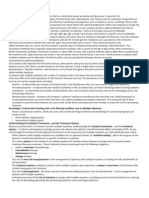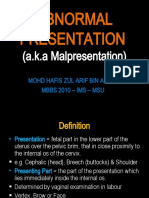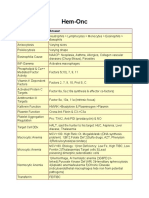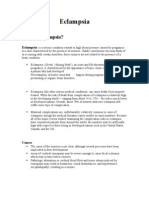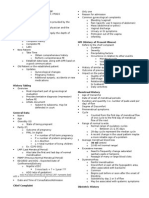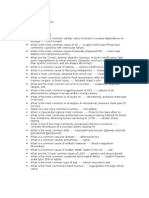Visual Mnemonics For Boards
Visual Mnemonics For Boards
Uploaded by
yepherenowCopyright:
Available Formats
Visual Mnemonics For Boards
Visual Mnemonics For Boards
Uploaded by
yepherenowOriginal Title
Copyright
Available Formats
Share this document
Did you find this document useful?
Is this content inappropriate?
Copyright:
Available Formats
Visual Mnemonics For Boards
Visual Mnemonics For Boards
Uploaded by
yepherenowCopyright:
Available Formats
Ulcerative Colitis
Description
Uterine leiomyomas are well-circumscribed, pseudoencapsulated, benign monoclonal tumors
composed mainly of smooth muscle with varying amounts of fibrous connective tissue (1,2).
3 major subtypes:
o Subserous: Common; external; may become pedunculated
o Intramural: Common; within myometrium; may cause marked uterine enlargement
o Submucous: ~5% of all cases; internal, evoking abnormal uterine bleeding and infection;
occasionally protruding from cervix
Rare locations: Broad, round, and uterosacral ligaments
System affected: Reproductive
Synonym(s): Fibroids; myoma; fibromyoma; myofibroma; fibroleiomyoma
Epidemiology
Incidence
Cumulative incidence is 70%, highest in perimenopausal age group
Incidence increases with each decade during reproductive years
Not seen in premenarchal females
Predominant sex: Females only
3 more frequent; occurs earlier in African Americans
Prevalence
411% of all women
2040% of women in reproductive years (2)
Risk Factors
African American heritage
Early menarche (<10 years)
Nulliparous
Hypertension
Familial predisposition
Obesity
Alcohol
Pathophysiology
Enlargement of benign smooth muscle tumors that may lead to symptoms affecting the reproductive, GI,
or genitourinary system
Etiology
Complex multifactorial process involving transition from normal myocyte to abnormal cells and then to
visibly evident tumor (monoclonal expansion):
Hormones (1): Increases in estrogen and progesterone are correlated with myoma formation (i.e.,
rarely seen before menarche). Estrogen receptors in myomas bind more estradiol than normal
myometrium (2).
You might also like
- UWorld Peds QuestionsDocument20 pagesUWorld Peds Questionsnajaida.shepardNo ratings yet
- Acute PancreatitisDocument31 pagesAcute PancreatitisAmoroso, Marian Corneth D.No ratings yet
- UW Notes PDFDocument99 pagesUW Notes PDFJoeNo ratings yet
- Notes: LymphomasDocument7 pagesNotes: LymphomasYA M AY100% (1)
- Preventive Health: Based On The USPSTF 2014Document42 pagesPreventive Health: Based On The USPSTF 2014Louella CarpioNo ratings yet
- What Is Multiple MyelomaDocument2 pagesWhat Is Multiple MyelomaRegine Garcia Lagazo100% (1)
- PreeclampsiaDocument34 pagesPreeclampsiaTrigo Puro100% (1)
- Congenital MalformationsDocument20 pagesCongenital Malformationsapi-19500641No ratings yet
- Abnormal Uterine BleedingDocument5 pagesAbnormal Uterine Bleedingwuryan dewiNo ratings yet
- Assessing Fetal and Maternal Health: Prenatal Care: Health Promotion During PregnancyDocument8 pagesAssessing Fetal and Maternal Health: Prenatal Care: Health Promotion During PregnancyMIKAELA DAVIDNo ratings yet
- Uworld Peds MicroDocument5 pagesUworld Peds MicroJoan ChoiNo ratings yet
- Infantile HemangiomaDocument25 pagesInfantile Hemangiomaicha_putyNo ratings yet
- ESRD Case StudyDocument8 pagesESRD Case Studycherry2989No ratings yet
- O&G - Abnormal PresentationDocument32 pagesO&G - Abnormal PresentationAnironOrionNo ratings yet
- Hem-Onc: AnswerDocument3 pagesHem-Onc: AnswerAman Raj KNo ratings yet
- Seizures and The Epilepsies in Infants, Children, and AdolescentsDocument8 pagesSeizures and The Epilepsies in Infants, Children, and AdolescentsCecille Ann CayetanoNo ratings yet
- Uworld ENT NotesDocument4 pagesUworld ENT Notes808kailua100% (1)
- Counselling, Breaking Bad NewsDocument26 pagesCounselling, Breaking Bad NewsArief NorddinNo ratings yet
- Carcinoma of The Breast - Bailey & LoveDocument5 pagesCarcinoma of The Breast - Bailey & LoveKeyshia Yazid100% (1)
- IRFAN MIR Clinical CorelationsDocument55 pagesIRFAN MIR Clinical CorelationssammieahemdNo ratings yet
- Anesthesia Monitoring in The Operating Room and ICU: Dr. Mahmoud Al-MustafaDocument47 pagesAnesthesia Monitoring in The Operating Room and ICU: Dr. Mahmoud Al-MustafaKatherine NovelaNo ratings yet
- Quiz YourselfDocument154 pagesQuiz YourselfKandykane0550% (2)
- Kawasaki DiseaseDocument14 pagesKawasaki DiseaseFransiskus Beat Batmomolin100% (1)
- Student OB H&PDocument1 pageStudent OB H&PauanpbvvNo ratings yet
- Wallenberg Syndrome: Publication DetailsDocument9 pagesWallenberg Syndrome: Publication DetailsHuang Jen Liang100% (1)
- Adnexal MassDocument28 pagesAdnexal MassJuan P. RuedaNo ratings yet
- Staghorn CalculiDocument60 pagesStaghorn CalculiEndang Yulia Angraini100% (1)
- Congenital Cyanotic Heart DiseaseDocument26 pagesCongenital Cyanotic Heart DiseaseAlokh Saha Raj100% (1)
- Surgery Case Report - AppendicitisDocument19 pagesSurgery Case Report - Appendicitissuperpickle87No ratings yet
- Patient Health History: Source of History: Patient and His Wife Percent Reliability: 92%Document42 pagesPatient Health History: Source of History: Patient and His Wife Percent Reliability: 92%Neil AlviarNo ratings yet
- Buzzwords For ExamsDocument16 pagesBuzzwords For ExamsU Rock BhalraamNo ratings yet
- MigraineDocument9 pagesMigraineRose Athena SibalaNo ratings yet
- Derma Case Write UpDocument9 pagesDerma Case Write UpAmbhi GanaNo ratings yet
- Upper and Lower GI Bleeding Differential DiagnosesDocument3 pagesUpper and Lower GI Bleeding Differential DiagnosesKEn PilapilNo ratings yet
- Ped OsceDocument4 pagesPed OsceAJ JeyakumarNo ratings yet
- Steroidal Anti - Inflammatory Drugs: NsaidsDocument96 pagesSteroidal Anti - Inflammatory Drugs: NsaidsDR AbidNo ratings yet
- Pediatrecs EmqDocument40 pagesPediatrecs Emqv_vijayakanth7656No ratings yet
- Acute Renal FailureDocument30 pagesAcute Renal FailureRudra DasNo ratings yet
- Paediatric History TakingDocument6 pagesPaediatric History Takingsubramaniam krishnamoorthi100% (1)
- Gynaecology and Obstetrics PDFDocument50 pagesGynaecology and Obstetrics PDFabdulmoiz92No ratings yet
- Heart MurmursDocument48 pagesHeart MurmursAhmed T Al-MomtinNo ratings yet
- EL Husseinys Essentials of PediatricsDocument253 pagesEL Husseinys Essentials of PediatricsMorozovschi Vitalie100% (1)
- Eclampsia OutputDocument5 pagesEclampsia OutputhailleyannNo ratings yet
- Triads in MedicineDocument4 pagesTriads in MedicineÐr SalmaNo ratings yet
- Von Willebrand DiseaseDocument63 pagesVon Willebrand Diseasesaad awanNo ratings yet
- Gynecology HXDocument4 pagesGynecology HXlovelots1234No ratings yet
- Urine Dipstick Testing + Common Renal Problem 2012Document52 pagesUrine Dipstick Testing + Common Renal Problem 2012Ainul ArinaNo ratings yet
- File:///c - /Users/User/Downloads/mcq - HTM (04-Aug-19 10:20:40 AM)Document52 pagesFile:///c - /Users/User/Downloads/mcq - HTM (04-Aug-19 10:20:40 AM)Mohamed IbrahimNo ratings yet
- NR 325 Neuro Worksheet 2Document6 pagesNR 325 Neuro Worksheet 2John Thomas100% (1)
- EV Neonatal JaundiceDocument24 pagesEV Neonatal JaundiceAlkrenaweeSrurNo ratings yet
- Pediatric CardiologyDocument30 pagesPediatric CardiologyZahra AlaradiNo ratings yet
- Nephroblastoma FinalDocument24 pagesNephroblastoma FinalKrissy_Singh_211No ratings yet
- Infective EndocarditisDocument18 pagesInfective EndocarditisMuzzaffer HussainNo ratings yet
- Obstetrics OverviewDocument91 pagesObstetrics OverviewAbi TudNo ratings yet
- The Most CommonsDocument80 pagesThe Most CommonsJmee8No ratings yet
- Pediatric Clinics Notes by Dr.P.Natarajan M.D .Document151 pagesPediatric Clinics Notes by Dr.P.Natarajan M.D .Pachiappan NatarajanNo ratings yet
- Essentials for Practice of Medicine in the Frontline: From Tropical Africa; Pleasantly Different Volume 2From EverandEssentials for Practice of Medicine in the Frontline: From Tropical Africa; Pleasantly Different Volume 2Rating: 5 out of 5 stars5/5 (1)
- A Simple Guide to Abdominal Aortic Aneurysm, Diagnosis, Treatment and Related ConditionsFrom EverandA Simple Guide to Abdominal Aortic Aneurysm, Diagnosis, Treatment and Related ConditionsNo ratings yet
- Antipsychotics: Crash Course Lecture July 2016 VersionDocument101 pagesAntipsychotics: Crash Course Lecture July 2016 Versionyepherenow100% (1)
- Step 3 Sample Questions 2015Document41 pagesStep 3 Sample Questions 2015yepherenow100% (2)
- DX of Aom or OmeDocument1 pageDX of Aom or OmeyepherenowNo ratings yet
- BoardReviewClass PsychiatryDocument28 pagesBoardReviewClass Psychiatryyepherenow100% (1)






